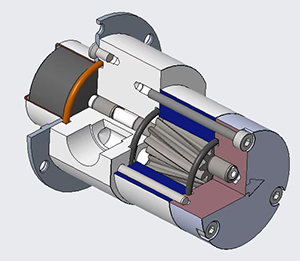A magnetic drive pump relies on liquid to lubricate and cool its components. Dry running deprives the pump of this essential liquid, leading to overheating and friction. Bearings, in particular, face immediate damage. Without proper precautions, this can result in costly repairs or complete pump failure.
What Happens When a Magnetic Drive Pump Runs Dry?
Loss of Lubrication
A magnetic drive pump depends on liquid to lubricate its internal components. When the pump operates without liquid, the bearings and other moving parts lose this essential lubrication. This lack of lubrication increases friction between components. Over time, this friction causes wear and tear, reducing the pump’s efficiency. Without proper lubrication, the pump’s lifespan shortens significantly.
Overheating and Friction
Dry running leads to overheating. The absence of liquid prevents the pump from dissipating heat generated during operation. As the temperature rises, the materials inside the pump can expand or deform. Friction between parts intensifies, further accelerating damage. Prolonged overheating may even cause the pump to seize, halting its operation entirely.
Risk of Catastrophic Failure
The combination of friction, heat, and material stress can result in catastrophic failure. Bearings may crack, and the magnetic coupling could lose alignment. In severe cases, the impeller or casing might sustain irreparable damage. Such failures often require costly repairs or complete replacement of the magnetic drive pump. Preventing dry running is essential to avoid these outcomes.
Key Components at Risk in a Magnetic Drive Pump
SiC Bearings
Silicon carbide (SiC) bearings are among the most vulnerable components in a magnetic drive pump. These bearings rely on liquid for lubrication and cooling. When dry running occurs, the absence of liquid causes rapid overheating. This heat can lead to cracking or complete failure of the bearings. Damaged SiC bearings reduce the pump’s efficiency and may result in costly repairs. Operators should prioritize protecting these bearings to maintain the pump’s performance.
Magnetic Coupling
The magnetic coupling plays a critical role in transferring torque from the motor to the impeller without direct contact. During dry running, the lack of liquid increases friction and heat within the pump. This can weaken the magnets or cause misalignment in the coupling. A compromised magnetic coupling disrupts the pump’s operation and may lead to further damage to other components. Regular monitoring helps detect early signs of wear in the coupling.
Impeller and Casing
The impeller and casing are essential for moving liquid through the pump. Dry running exposes these parts to excessive heat and friction. Over time, this can cause warping, cracking, or erosion of the materials. In severe cases, the impeller may seize, rendering the pump inoperable. Protecting the impeller and casing requires ensuring proper liquid levels and avoiding conditions that lead to dry running.
Detecting Damage in a Magnetic Drive Pump
Increased Vibration
Increased vibration often signals damage in a magnetic drive pump. When internal components, such as bearings or the impeller, experience wear, they can create imbalances. These imbalances lead to excessive vibration during operation. Over time, this vibration may worsen, causing further damage to the pump. Operators should monitor vibration levels regularly. Using vibration sensors can help detect abnormalities early, preventing more severe issues.
Unusual Operational Noise
Unusual noises often indicate internal damage. A magnetic drive pump typically operates quietly. However, damaged bearings or misaligned components can produce grinding, squealing, or knocking sounds. These noises suggest friction or misalignment within the pump. Ignoring these signs may lead to catastrophic failure. Regular auditory inspections can help identify these issues before they escalate.
Higher Power Consumption
A damaged pump often requires more energy to perform its tasks. Friction from worn bearings or misaligned parts increases resistance, forcing the motor to work harder. This results in higher power consumption. Monitoring energy usage can provide valuable insights into the pump’s condition. A sudden spike in power consumption often indicates internal damage that needs immediate attention.
Best Practices to Prevent Dry Running
Use of Power Monitors
Power monitors play a crucial role in preventing dry running in a pump. These devices track the energy consumption of the pump during operation. A sudden drop in power usage often indicates that the pump is running dry.
By installing power monitors, operators can receive real-time alerts when abnormal conditions occur. This allows them to shut down the pump immediately, preventing further damage. Power monitors are a cost-effective solution for protecting the pump and extending its lifespan.
Regular Maintenance
Regular maintenance ensures that a pump operates efficiently and reduces the risk of dry running. Inspections should focus on critical components like bearings, the impeller, and the magnetic coupling. Cleaning and replacing worn parts during scheduled maintenance can prevent unexpected failures.
Operators should also check for blockages in the pump’s system that might restrict liquid flow. A well-maintained pump is less likely to experience dry running, saving time and money in the long term.
Ensuring Proper Liquid Levels
Maintaining proper liquid levels is essential for the safe operation of a pump. Operators should monitor the liquid supply to ensure it meets the pump’s requirements. Installing liquid level sensors can provide automatic alerts when levels drop too low.
These sensors help prevent dry running by shutting down the pump before damage occurs. Additionally, operators should verify that the liquid source remains unobstructed and consistent. Proper liquid levels keep the pump lubricated and cool, ensuring optimal performance.
Conclusion
Running a magnetic drive pump without liquid leads to severe risks. Damage to SiC bearings and other components often results from a dry run operation. Proactive measures, such as regular inspections and monitoring systems, help prevent this issue. By understanding these risks and adopting best practices, operators can extend pump life, reduce downtime, and avoid costly repairs.





















